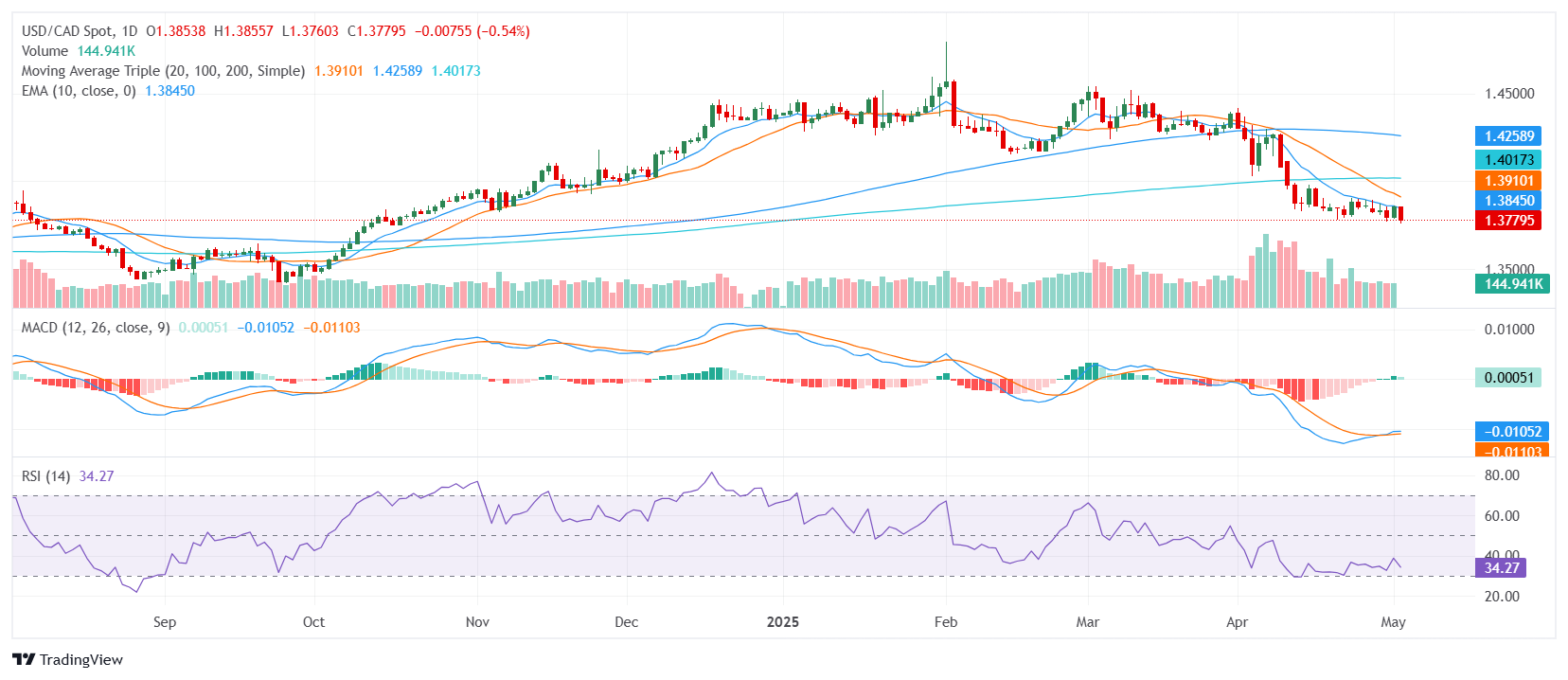USD/CAD dips as easing trade tensions and soft US data weigh on Greenback
- The USD/CAD is trading lower around the 1.3800 area, giving up recent gains amid a broadly weaker US Dollar and improving risk sentiment.
- US Nonfarm Payrolls came in better than expected at 177,000, but soft ISM and jobless claims data keep Fed rate cut bets intact, while Canada remains sidelined.
- Technical indicators remain bearish, with key resistance at 1.3844 and support levels eyed around 1.3760.
The USD/CAD is trading with losses around the 1.3800 level on Friday, as the pair continues to retreat from the prior session’s highs. The move comes as the US Dollar weakens broadly across the board after a failed attempt to reclaim the 100.00 mark on the US Dollar Index (DXY). Markets are digesting the latest round of labor data out of the US while positioning ahead of potential trade negotiations between the US and China.
April’s Nonfarm Payrolls (NFP) report showed that the US economy added 177,000 jobs, topping expectations of 130,000 and easing fears of a sharp labor market slowdown. However, details revealed that February and March payrolls were revised lower by a combined 58,000 jobs, while the Unemployment Rate held steady at 4.2%. Wage growth came in at 3.8% year-over-year, slightly below expectations. Initial jobless claims rose to 241,000 in the latest week, the highest since mid-February, and continuing claims hit their highest level since November 2021. These data points suggest that cracks are emerging in the labor market, keeping hopes of a Federal Reserve rate cut alive for as early as July.
Meanwhile, the ISM Manufacturing PMI softened further in April, slipping to 48.7 from 49.0 in March. The production sub-index declined notably to 44.0, indicating weakening output, although new orders and employment showed marginal improvement. The price index rose modestly to 69.8, its highest since mid-2022, keeping inflation concerns in play.
Trade optimism added to the Canadian Dollar’s strength. Reports that China may be open to restarting tariff talks with the US sparked renewed hopes of easing global trade tensions. Canadian economic data remained limited, but the loonie found support from overall risk appetite and commodity-linked flows, particularly as energy and metals prices stabilize. No major releases are expected out of Canada ahead of next week’s labor market data.
Technical Analysis
From a technical standpoint, USD/CAD exhibits a bearish overall signal, currently trading around 1.3800 and positioned mid-range between 1.3760 and 1.3856. The 10-day EMA at 1.3844 and the 10-day SMA at 1.3834 continue to pressure the pair from above. While the MACD suggests a mild bullish bias, the RSI at 34.67 remains neutral, and the Commodity Channel Index (CCI) at -78.77 signals weak momentum. Longer-term indicators including the 20-day SMA at 1.3908, 100-day SMA at 1.4254, and 200-day SMA at 1.4011 all reinforce the broader downside risk.
Immediate resistance is located at 1.3807, followed by 1.3834 and 1.3844. On the downside, support lies at 1.3760 — the session low — with further levels seen around 1.3730 and 1.3690. Unless the pair reclaims the short-term moving averages, the bias remains tilted to the downside heading into next week.
Daily Chart

Forex News
Keep up with the financial markets, know what's happening and what is affecting the markets with our latest market updates. Analyze market movers, trends and build your trading strategies accordingly.



















